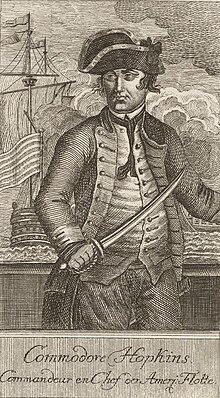Esek Hopkins
| Esek Hopkins | |
|---|---|
 |
|
| Born |
April 26, 1718 Scituate, Colony of Rhode Island and Providence Plantations |
| Died | February 26, 1802 (aged 83) Providence, Rhode Island |
| Buried at | North Burial Ground, Providence |
| Allegiance |
|
| Service/branch |
|
| Years of service | 1775–1778 |
| Rank |
|
| Battles/wars |
French and Indian War American Revolutionary War |
| Spouse(s) | Desire Burroughs |
| Signature |  |
Commodore Esek Hopkins (April 26, 1718 – February 26, 1802) was the only Commander in Chief of the Continental Navy during the American Revolutionary War. He was also an accomplished merchant captain and privateer.
Esek Hopkins was born in Scituate, Rhode Island. Before the Revolutionary War he had sailed to nearly every quarter of the earth, commanded a privateer in the French and Indian War, and served as a deputy to the Rhode Island General Assembly. Appointed a brigadier general to command all military forces of Rhode Island in October 4, 1775, he immediately began to strengthen Rhode Island's defenses with the help of his deputy, William West. A few months later, December 22, 1775, Hopkins was appointed Commander in Chief of the Continental Navy authorized by the Continental Congress to protect American commerce.
In September 1764, during his time as a privateer and merchant, Hopkins took command of the slave ship Sally, owned by Nicholas Brown and Company. Hopkins had no prior experience in operating a slave trading vessel at the time, and the 15-month voyage would result in disaster with 109 out of 196 slaves dying after being acquired. In late 1765, Sally arrived at its first trading destination in the West Indies, but the surviving African captives were in such poor health that most sold for very little. Hopkins' failed command of Sally contributed to the Brown brothers reconsidering their participation in the active slave trade of Rhode Island in the 18th century.
On January 5, 1776, Congress gave Hopkins his set of orders: "You are instructed with the utmost diligence to proceed with the said fleet to sea and if the winds and weather will possibly admit of it to proceed directly for Chesapeake Bay in Virginia and when nearly arrived there you will send forward a small swift sailing vessel to gain intelligence....If...you find that they are not greatly superior to your own you are immediately to enter the said bay, search out and attack, take or destroy all the naval force of our enemies that you may find there. If you should be so fortunate as to execute this business successfully in Virginia you are then to proceed immediately to the southward and make yourself master of such forces as the enemy may have both in North and South Carolina...Notwithstanding these particular orders, which it is hoped you will be able to execute, if bad winds, or stormy weather, or any other unforeseen accident or disaster disenable you so to do, you are then to follow such courses as your best Judgment shall suggest to you as most useful to the American cause and to distress the Enemy by all means in your power."
...
Wikipedia
